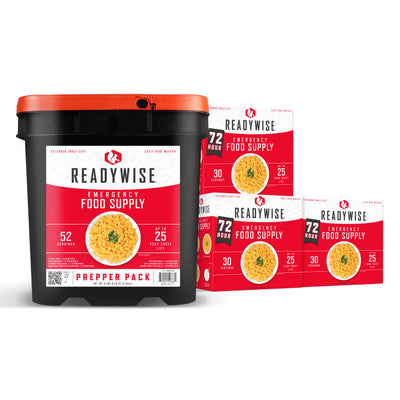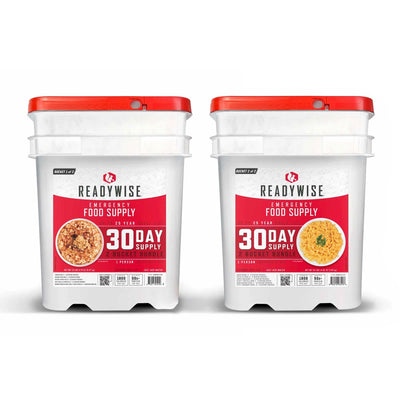Your body requires water—it’s the foundation of survival, the elixir of life. In an emergency, when access to clean water is compromised, having a sufficient supply can stave off the dire effects of dehydration.
That said, disaster situations can quickly disrupt water availability, leaving people vulnerable to illness and sanitation issues. Water contamination from floods, chemical spills, or compromised municipal systems further underscores the necessity of preparedness.
By understanding how much water for emergency supply and how to maintain its safety, you can empower yourself and your family to navigate emergencies with a glass half full.
Recommended Water Storage Guidelines
The general rule of thumb for emergency preparedness is to store at least one gallon of water per person per day for a minimum of three days. This amount accounts for both drinking and basic hygiene needs.1
However, the three-day recommendation is just a baseline.
The CDC suggests aiming for a two-week supply to better withstand prolonged crises.1
Individual circumstances should further dictate adjustments to this guideline. For instance, a family living in an arid climate may require more water per day due to increased perspiration and evaporation rates. Similarly, those with medical conditions, infants needing formula, or individuals engaged in strenuous activities will need a greater water reserve.
Factors Influencing Water Requirements
To adequately fill your water reserves, it’s critical to take into account various elements that may influence the amount of water you and your loved ones need during an emergency.
We outline a few key considerations below.
Climate and Temperature
The hotter the environment, the higher the water demand. In regions with extreme heat or high humidity, dehydration can set in quickly, requiring a greater daily intake.
Outdoor exposure only intensifies this need—hikers, campers, or those forced to evacuate on foot will require significantly more than the standard gallon per day.
Health and Medical Needs
Your health status or the status of your loved ones can impact the amount of water you’ll need. This includes people with conditions that cause dehydration, such as2:
- Kidney disease Diabetes Celiac disease Sjögren's disease Ulcerative colitis Cystic fibrosis Crohn’s disease POTS syndrome Addison's disease Gastroenteritis Hyperthyroidism Sepsis Cancer
Additionally, pregnant and breastfeeding women have higher fluid needs to support both their own health and that of their child.3 Individuals who rely on medications that cause dehydration or diuretics should also plan for increased water storage.
Age and Activity Level
Age plays a significant role in hydration needs. Infants and young children dehydrate faster than adults, necessitating extra stored water.4 Similarly, elderly individuals, who may have a diminished thirst response or underlying health concerns, should be accounted for in emergency water calculations.
Physically active individuals, especially those performing labor-intensive tasks like clearing debris or rebuilding after a disaster, will sweat more and require additional water intake, too.
Calculating Your Personal Water Storage Needs
To determine the right amount of water for your household, consider the following factors:
- Number of people in your home Climate and likelihood of extreme weather Any medical conditions requiring extra hydration Activity levels and potential physical exertion Presence of infants, elderly family members, pets, or livestock
For example, a family of four in a hot climate should consider storing closer to two gallons per person per day. Households with pets must account for their hydration needs as well—dogs require roughly one ounce of water per pound of body weight daily, while cats typically consume between five to ten ounces per day.5
Livestock owners should also make arrangements for significantly larger reserves based on species and size.
Best Practices for Water Storage
Calculating how much water you’ll need is only half the battle. It’s also critical to find storage solutions that keep your water safe from outside elements.
Here’s a quick how-to.
#1 Choose Appropriate Containers
Selecting the right containers is crucial for maintaining water quality. Use food-grade, BPA-free plastic or glass containers specifically designed for water storage.
Large, durable water barrels (such as 55-gallon drums) work well for long-term supplies, while smaller, portable containers—like a filtration bottle—are useful for evacuation scenarios.
#2 Properly Store the Water
Water should be kept in a cool, dark place away from direct sunlight to prevent algae growth and plastic degradation. Avoid storing water near chemicals, gasoline, or cleaning products, as these substances can leach harmful fumes into the supply.
#3 Regularly Maintain the Water
Stored water should be rotated every six months to maintain freshness. While commercially bottled water has a longer shelf life, home-stored water should be checked for any signs of contamination.
Keeping a purification method on hand also ensures stored water remains potable if concerns arise.
Water Purification Methods
To ensure your water is safe for drinking, we recommend the following solutions.
#1 Boiling
Boiling is the most effective method for killing pathogens. Bring water to a rolling boil for at least one minute (or three minutes at higher altitudes) to ensure safety.
This method is best suited for small batches and should be used in combination with filtration for water from questionable sources.
#2 Chemical Treatments
Water purification tablets or liquid chlorine bleach (without added fragrances or detergents) can disinfect water in an emergency. The general guideline is to add eight drops of unscented bleach per gallon of water, stir, and let it sit for 30 minutes.6
If the water remains cloudy, an additional dose or filtration may be necessary.
#3 Filtration Systems
Portable water filters, such as pump filters or gravity-fed systems, provide an effective way to remove:
- Bacteria Parasites Debris
Some advanced filters can also remove viruses and heavy metals. Investing in a high-quality filter ensures access to safe drinking water from natural or stored sources.
Additional Considerations
To ensure your emergency water supplies are adequate, keep the following in mind:
- Water sanitation – Drinking water is a priority, but sanitation water is equally important. Handwashing, dishwashing, and toilet flushing require additional reserves. Keeping separate containers for non-potable uses prevents unnecessary depletion of drinking water. Local water sources – In prolonged emergencies, finding alternative water sources is crucial. Lakes, rivers, and rainwater collection can supplement stored supplies if properly purified with a water filter. That said, familiarizing yourself with purification techniques before an emergency ensures you can safely utilize these resources if needed.
Keep Your Head Above the Water
Water is a non-negotiable component of emergency preparedness. By assessing your household’s specific needs, properly storing water, and understanding purification techniques, you can ensure that you’re ready for any situation.
Whether facing a short-term disruption or a prolonged crisis, an adequate water supply provides security, comfort, and the ability to make sound decisions in times of uncertainty—and ReadyWise provides the supplies you need to feel prepared, from water storage solutions to water filters.
Don’t wait for an emergency to strike—start building your water reserves today.
Sources:
- CDC. How to Create and Store an Emergency Water Supply. https://www.cdc.gov/water-emergency/about/how-to-create-and-store-an-emergency-water-supply.html
- VeryWellHealth. 12 Diseases That Can Cause Dehydration in Adults. https://www.verywellhealth.com/diseases-that-cause-dehydration-in-adults-8679450
- BMC Pregnancy and Childbirth. Association between total water intake and dietary intake of pregnant and breastfeeding women in China: a cross-sectional survey. https://bmcpregnancychildbirth.biomedcentral.com/articles/10.1186/s12884-019-2301-z
- The Royal Children’s Hospital. Dehydration. https://www.rch.org.au/kidsinfo/fact_sheets/Dehydration/
- Hill’s. How Much Water Should Dogs & Cats Drink Each Day? https://www.hillspet.com/pet-care/nutrition-feeding/how-much-water-should-dogs-and-cats-drink
- EPA. Emergency Disinfection of Drinking Water. https://www.epa.gov/ground-water-and-drinking-water/emergency-disinfection-drinking-water
















































































